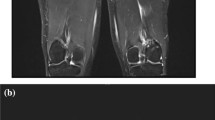Abstract
Objective
To determine the pubic bone fracture incidence and associated injury patterns in patients with core muscle injury.
Materials and methods
Ninety-three consecutive patients with core muscle injury protocol MRI showing rectus abdominis-adductor longus aponeurotic plate injuries from June 2007 through August 2017 were independently analyzed in blinded fashion by two musculoskeletal radiologists for the presence or absence of pubic bone fracture. A variety of other osseous and soft tissue injury characteristics were recorded. Pain duration prior to MRI and return to play time were taken from the clinical record. Statistical analysis included fracture incidence as well as the association of fracture with other injury characteristics, duration of pain, and return to play time.
Results
Eighty-seven men and six women with a mean age of 34.4 years (range, 16–66 years) were included in the study cohort. Overall fracture incidence was 18.3% (17/93) including 13 fatigue fractures of the pubic body and four elevated cortical fractures/fragments. After correction for multiple comparisons, no strong association was identified with osseous or soft tissue injury characteristics, pain duration, or return to play time.
Conclusions
Pubic fractures—particularly fatigue fractures—are a common co-existing injury in patients with a wide range of core muscle injury patterns. The presence of fracture did not have a strong correlation with injury patterns, pain duration, or return to play time but may have implications for patient management.



Similar content being viewed by others
References
Morelli V, Smith V. Groin injuries in athletes. Am Fam Physician. 2001;64(8):1405–14.
Orchard JW. Men at higher risk of groin injuries in elite team sports: a systematic review. Br J Sports Med. 2015;49(12):798–802.
Whittaker JL, Small C, Maffey L, Emery CA. Risk factors for groin injury in sport: an updated systematic review. Br J Sports Med. 2015;49:803–9.
Poor AE, Roedl JB, Zoga AC, Meyers WC. Core muscle injuries in athletes. Curr Sports Med Rep. 2018;17(2):54–8.
Khan W, Zoga AC, Meyers WC. Magnetic resonance imaging of athletic Pubalgia and the sports hernia. Current understanding and practice. Magn Reson Imaging Clin N Am. 2013;21:97–110.
Zoga AC, Mullens FE, Meyers WC. The spectrum of MR imaging in athletic Pubalgia. Radiol Clin N Am. 2010;48:1179–97.
Elattar O, Choi HR, Dills VD, Busconi B. Groin injuries (athletic Pubalgia) and return to play. Sports Health. 2016;8(4):313–23.
Byrne CA, Bowden DJ, Alkhayat A, Kavanagh EC, Eustace SJ. Sports-related groin pain secondary to symphysis pubis disorders: correlation between MRI findings and outcome after fluoroscopy-guided injection of steroid and local anesthetic. AJR. 2017;209:380–8.
Zoga AC, Kavanagh EC, Omar IM, Morrison WB, Koulouris G, Lopez H, et al. Athletic Pubalgia and the “sports hernia”: MR imaging findings. Radiology. 2008;247(3):797–807.
Brennan D, O’Connell MJ, Ryan M, Cunningham P, Taylor D, Cronin C, et al. Secondary cleft sign as a marker of injury in athletes with groin pain: MR image appearance and interpretation. Radiology. 2005;235(1):162–7.
Omar IM, Zoga AC, Kavanagh EC, Koulouris G, Bergin D, Gopez AG, et al. Athletic Pubalgia and “sports hernia”: optimal MR imaging technique and findings. RadioGraphics. 2008;28(5):1415–38.
Miller C, Major N, Toth A. Pelvic stress injuries in the athlete: management and prevention. Sports Med. 2003;33(13):1003–12.
Meyers WC, Yoo E, Devon ON, Jain N, Horner M, Lauencin C, et al. Understanding “sports hernia” (athletic Pubalgia): the anatomic and pathophysiologic basis for abdominal and groin pain in athletes. Oper Tech Sports Med. 2007;15(4):165–77.
Anderson K, Strickland SM, Warren R. Hip and groin injuries in athletes. Am J Sports Med. 2001;29(4):521–33.
Byrne CA, Bowden DJ, Alkhayat A, Kavanagh EC, Eustace SJ. Sports-related groin pain secondary to symphysis pubis disorders: correlation between MRI findings and outcome after fluoroscopy-guided injection of steroid and local anesthetic. Am J Roentgenol. 2017;209(2):380–8.
Kagel EM, Majeska RJ, Einhorn TA. Effects of diabetes and steroids on fracture healing. Curr Opin Orthop. 1995;6(5):7–13.
Boursinos LA, Karachalios T, Poultsides L, Malizos KN. Do steroids, conventional non-steroidal anti-inflammatory drugs and selective Cox-2 inhibitors adversely affect fracture healing? J Musculoskelet Neuronal Interact. 2009;9(1):44–52.
Author information
Authors and Affiliations
Corresponding author
Ethics declarations
Conflict of interest
The authors declare that they have no conflicts of interest.
Additional information
Publisher’s note
Springer Nature remains neutral with regard to jurisdictional claims in published maps and institutional affiliations.
Rights and permissions
About this article
Cite this article
Delic, J.A., Ross, A.B., Blankenbaker, D.G. et al. Incidence and implications of fracture in core muscle injury. Skeletal Radiol 48, 1991–1997 (2019). https://doi.org/10.1007/s00256-019-03249-2
Received:
Revised:
Accepted:
Published:
Issue Date:
DOI: https://doi.org/10.1007/s00256-019-03249-2




